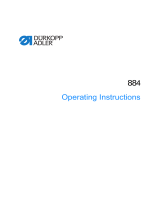
1
Class 267 Operating Instructions
Table of Contents/
General ....................................................................................................................................... 6
Class 267- with subclasses.......................................................................................................................... 6 1.1
References and illustration .......................................................................................................................... 6 1.2
Instaling the belt guard (see fig. 1 and 2) .................................................................................................... 6 1.3
Taking into service ....................................................................................................................................... 6 1.4
Control elements and functional elements on the sewing machine ................................................. 7
Basic equipment of the subclass 267 .......................................................................................................... 7 2.1
Basic equipment of further subclasses ........................................................................................................ 7 2.2
Instructions for sewing .................................................................................................................. 7
Needle .......................................................................................................................................................... 7 3.1
3.1.1
Needle change ......................................................................................................................................... 7
Threads ........................................................................................................................................................ 7 3.2
3.2.1
Threading of needle thread ...................................................................................................................... 8
Thread tension ............................................................................................................................................. 8 3.3
3.3.1
Adjusting the thread tensions................................................................................................................... 8
3.3.2 Lifting the thread tension .......................................................................................................................... 9
Bobbin thread ............................................................................................................................................... 9 3.4
3.4.1
Winding the bobbin thread (fig. 3) ............................................................................................................ 9
3.4.2 Bobbin change ......................................................................................................................................... 9
3.4.3 Adjusting the bobin thread tension .......................................................................................................... 9
Presser foot ................................................................................................................................................ 10 3.5
3.5.1
Lifting the presser foot ........................................................................................................................... 10
3.5.2 Regulating the presser foot .................................................................................................................... 10
3.5.3 Changing the presser foot ...................................................................................................................... 10
Feed ........................................................................................................................................................... 10 3.6
3.6.1
Feed dog ................................................................................................................................................ 10
3.6.1.1 Stitch length ................................................................................................................................... 10
3.6.1.2 Stitch regulator ............................................................................................................................... 10
3.6.1.3 Bartacking ...................................................................................................................................... 10
Functions-description of further subclasses ................................................................................. 11
Needle feed and alternating top feed ......................................................................................................... 11 4.1
4.1.1
Adjusting the stitch length ...................................................................................................................... 11
4.1.2 Adjusting the alternating top feed .......................................................................................................... 11
Maintenance .............................................................................................................................. 11
Cleaning ..................................................................................................................................................... 11 5.1
Oil lubrication (fig. 8) .................................................................................................................................. 11 5.2
5.2.1
Oil qualities............................................................................................................................................. 11



































